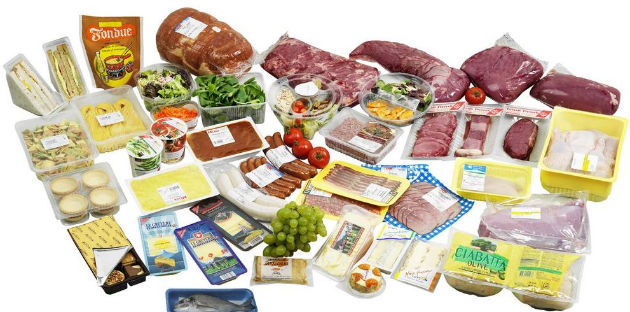BARRIER POLYMERS
Many polymers such as polyolefins (polyethylene, polypropylene), poly(vinyl chloride), aliphatic polyamides, poly(ethylene terephthalate), polycarbonate, and others are used as protective barrier films against the mass transport of small molecules of gases, vapors, and liquids (known as diffusates, permeants) in different applications. The barrier properties depend on the polymer characteristics such as solubility, diffusion, permeability, and others, the nature of the fluid, temperature, and other factors.
Barrier polymers are used for many packaging and protective applications. As barriers, they separate a system, such as an article of food or an electronic component, from an environment.
Barrier polymers limit the movement of substances called permeants. The movement can be through the polymer or, in some cases, merely into the polymer. After crossing the barrier polymer, the permeant moves to the polymer surface, desorbs and moves away. Permeant movement is a physical process with both a thermodynamic and a kinetic component.
BARRIER PROPERTIES OF POLYMERS
PERMEABILITY, SOLUBILITY, AND DIFFUSIVITY
The permeability or inverse barrier is an important physical property for many industrial and biomedical applications of polymers. For example, polymers with low permeability, i.e., high barrier properties, are required for food packaging applications to prevent loss of flavor, color and quality and retard spoilage.
| Polyethylene (PE) | Heat-sealable food contact layer
Moisture barrier Can be combined with gas/aroma barriers (e.g., PA, EVOH) | Breathable packaging for fresh produce LDPE, HDPE
Carton liners (LLDPE) |
| Polypropylene (PP) | Moisture barrier
To provide mechanical strength Can be coated with heat seal coatings (PVDC, acrylate) Can be combined with gas/aroma barriers (e.g., PVDC coatings, PA, EVOH) | Modified atmosphere packaging thermoformed containers for microwavable packaging, hot-filled packaging |
| Polyamide (PA) | Gas/aroma barrier
To provide mechanical strength Heat resistance Can be used as outside layer of a heat seal film → film will not stick to the sealing bar surface | Boil-in-bag packaging
Thermoformed packaging |
| Polyethylene Terephthalate (PET) | Gas/aroma barrier
Moisture barrier To provide mechanical strength Heat resistance | Plastic bottles for carbonated soft drinks
Meat and cheese packaging Snack food wrapper Boil-in-bag Sterilizable pouches Ovenware containers |
| Polystyrene (PS) | Gas permeability
Printability Can be combined with gas/aroma barriers (coextruded or laminated) → commercially available structures: e.g., PS/PVDC/PS, PS/PVDC/PE, PS/EVOH/PE, PS/EVOH/PP | Breathable packaging for fresh produce (e.g., fresh meat packaging) printable outside layers |
| Ethylene Vinyl Alcohol (EVOH) | Oxygen barrier
Needs to be protected from moisture → often sandwiched (coextruded) between PE or PP, in some applications also sandwiched between PET, PA, or PS | Modified atmosphere packaging
Packing of oxygen-sensitive food |
| Polyvinylidene Chloride (PVDC) | Gas/aroma and/or moisture barrier
To protect the surface from scratches and abrasion Heat-sealable food contact layer Often copolymers of vinylidene-chloride and ester-type monomers (e.g., ethyl acrylate) | Modified atmosphere packaging applied as coating or coextruded film |
| Ethylene Vinyl Acetate (EVA) | Moisture barrier
Adhesion layer (tie layer) for coextrusion of polar (e,g., PA, PET-G) and non-polar (e.g., PE) or BOPP films | Modified atmosphere packaging applied as coating or coextruded film |
| Polycarbonate (PC) | Polycarbonate (PC)
Mechanical strength Moisture barrier | Microwavable packaging, hot-filled packaging
Modified atmosphere packaging barriers for fruit juice cartons |
| Polyvinylchloride (PVC) | Gas/aroma barrier
Mechanical strength | Fresh food packaging (e.g., PVC/PE films)
Modified atmosphere packaging (e.g., PVC, EVOH, PE films) |
| Polyethylene Naphthalate (PEN) | Gas/aroma and moisture barrier heat resistance | For hot refills, rewashing, reuse beverage bottles (e.g., beer) |
| Glycol modified polyethylene terephthalate (PET-G) | Heat-sealable food contact layer | Unit dose pharmaceutical
Blister packaging |
| Ethylene Acrylic Acid (EAA) | Extrusion coating tie layer between aluminum foil and other polymers Heat-sealable food contact layer Grease resistance Chemical resistance | Food packaging applied as tie layer or heat seal layer |
| Ionomer | Extrusion coating tie layer between aluminum foil and other polymers
Heat-sealable food contact layer Heat seal through fat and contaminants Superior grease resistance Superior chemical resistance | Food packaging applied as tie layer or heat seal layer |



